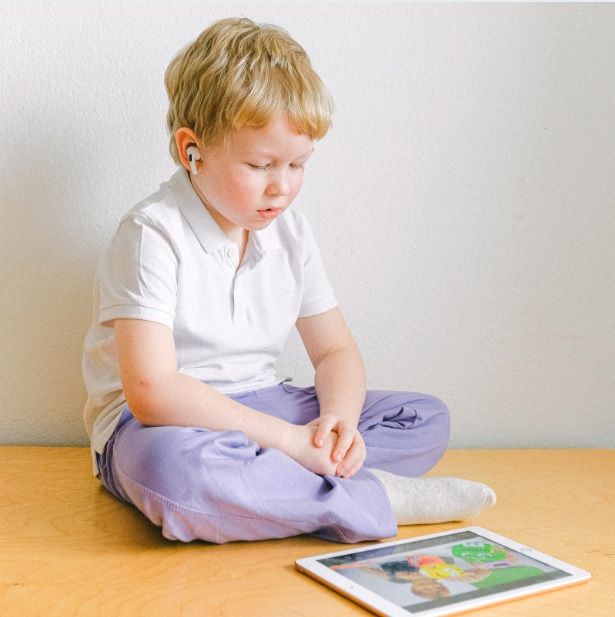Children and Technology – Why This is Important
In our current world children and technology go hand in hand. It’s important to limit childrens technology use and get our kids moving and interacting with others.
Gone are the days when toys and books could keep them engaged and quiet. Now-a-days, nothing short of an ipad, smartphone, or laptop is required and that’s just the start of it.
If you want some ideas to limit childrens technology use read our article.
Face it, when your 2 year old demands an ipad more than a toy, we have a problem!
What we have is not a healthy relationship between our children and technology but an addictive one.
The benefits of technology are well known: educational games and apps, connection to friends and access to information and services.
Its negative impact on our child’s health and learning must be looked into. And it is for this reason, that we look to limit childrens technology use.
But how? This is probably the most troublesome issue that we as parents face today. Technology has integrated itself into every part of our lives.
Here are some ways you can set healthy boundaries around children and technology and limit childrens technology use.

Children and Technology – A Look at The Negatives
Every parent is aware of the adverse effects of technology on children.
Here’s why we need to look at limiting childrens technology use.
Health issues
Increased screen time facilitates a sedentary lifestyle with children and technology.
Reduced outdoor play can lead to health issues like Vitamin D deficiency, poor immunity, physical strength and endurance.
To reduce growing obesity rates we need to be limiting childrens technology use.
Disturbed sleep patterns

Studies found that the blue light emitted from screens could disturb the child’s circadian rhythm (the sleep/wake pattern).
This occurs by suppressing the production of the hormone, melatonin.
It affected both the quality and quantity of the child’s sleep by causing insomnia, increased frequency of night waking and tiredness the next day.
Poor sleep has become a real problem around children and technology use.
Poor communication and socialization skills
Prolonged use of technology decreases a child’s interest in active social play.
When this occurs at a young age, children fail to develop age appropriate communication and social skills.
These include verbal, non-verbal and listening skills as well as the ability to interact with peers.
It could also impair their ability to display socially appropriate behaviors.
Taking responsibility for their actions, controlling emotions and understanding vital social cues are lost.
With the rise of hyperactivity disorders you can see why limiting childrens technology use has become very important.
Children do 1 of 2 things. They either try to avoid social interactions to spend more time with their devices.
Or use their devices to avoid social situations as it causes them anxiety.
Loss of social skills is a big problem with children and technology.
Cognitive disturbances
Increased moodiness, irritability, excessive boredom, poor attention, reduced focus and inability to engage in self-directed play.
These are some of the cognitive disturbances reported with excessive screen use.
How many of these behaviors do you see in your children?
Is it time to limit childrens technology use?

Threat to safety
The internet is a gateway to the world outside, and for growing children, this can be dangerous.
Children are lulled into false security with “online friendships”.
They may be exposed to inappropriate content and affect their perception of the world around them.
The threat to our child’s safety and privacy is another growing concern associated with children and technology.
Children and Technology – Limiting Your Child’s Technology Use
Now that we have understood the need for limiting our child’s technology use, let’s explore the different ways to make this possible. You can also this helpful article, Mobile Tracker App: Best for Digital Parenting.
But first a word of caution: Always get your partner on board with your plans! Because where’s the point if one parent was to say “yes” to the things we were trying to limit.
There is nothing more difficult than hearing “but papa said I could” (or mummy said, which would be extremely rare). Now you cannot override that permission unless it’s at the risk of undermining your partner’s parental role.
So first step is to make sure both parents are on the same page!

Set a good example
Before we start pointing fingers, let’s first examine and reduce our own dependence on technology.
Try to limit your use of devices to working hours (be it within or outside the house.)
As children learn through observation and imitation, it’s crucial that we set good examples.
By refraining our own technology use when around them we set a great foundation to limiting childrens technology use.
Educate your child
Children are more likely to follow your rules when they understand the purpose behind them.
Using stories, posters and toys explains to younger children the consequences of excessive technology use.
It can show them the dangers around children and technology.
Hold children accountable
Include your child when setting rules. Ask them for their input. Explain the importance of the relationship between children and technology.
Have a conversation on the world around them and if we limit childrens technology use this may solve some issues.
You could create a contract, a written document between parent and child showing the rules and explaining acceptable use of technology.
A document created by both parties holds the child accountable for their actions. and encourages them to reduce their use of devices.
This technique is most useful with older children.

Create tech-free zones and times
Limit your childrens technology use by creating tech-free zones in the house, such as the dining room and bedroom.
You can also limit the amount of time children use their devices.
Encourage them to completely avoid using them:
- During meal times.
- Before going to school and immediately after coming back from school.
- Before bed.
- When at a family outing.
Use these for interaction with real people and not children with technology.
Reward system
Use technology as a reward for good behavior, completed activities and chores.
Encourage children to earn their use of devices rather than have them on tap.
Getting them out and about and listening will also limit childrens technology use.
However, ensure that the time earned does not exceed the limits already set.
Use Tech-bins

Create a tech-bin, a basket in which any device can be placed. Doing this creates an environment free from distractions with children and technology.
For instance, children can be instructed to leave their phones inside the bin until their homework has been completed.
We found this an easy way to limit childrens technology use.
You can even try this technique for yourself, as it will free you from unnecessary distractions.
Especially when engaged in a task or interacting with your child.
Increase time for active play
Create opportunities and encourage your child to engage in active indoor and outdoor play to limit childres technology use.
Take them outside, read to them or engage the child in simple do-it-yourself projects.
Stimulate active play and reduce their dependence on screen time.
Tech-detox
Children and technology need a time to unplug and detox, even as a family.
Take a trip, go for a picnic or plan a fun-filled activity that does not include your devices.
At the very least limits its use to emergency purposes.
Conclusion
There is a famous quote “a family that sticks together, stays together!”
Likewise, developing a healthy relation between our children and technology can be a lot easier if we were to reach for the goal as a family.
By modeling the right behaviors and setting boundaries we can help limit our child’s technology use.
My name is Andrea Thompson and I’m a home based freelance writer. I’m 23 years old, married to my best friend, and mother to a wonderfully independent and opinionated 3 year old girl and step-mother to a sweet seven year old boy. I live in a tiny, little town in Kentucky, where I spend my free time fishing with my kids.
Writing has always been my passion, which I followed through high school, and for a while in college. Life happened, and once I discovered we were pregnant, I switched directions; opting for the healthcare industry because of the stability.
Finally, years later, I was in a place where I could leave the day job that never truly made me happy, and pursue my dreams. I’ve built, and am still building, my writing career from scratch. But, I’m passionate and I’m good at what I do. And, in the end, I can prove to my daughter that she can do anything she wants with this life.





